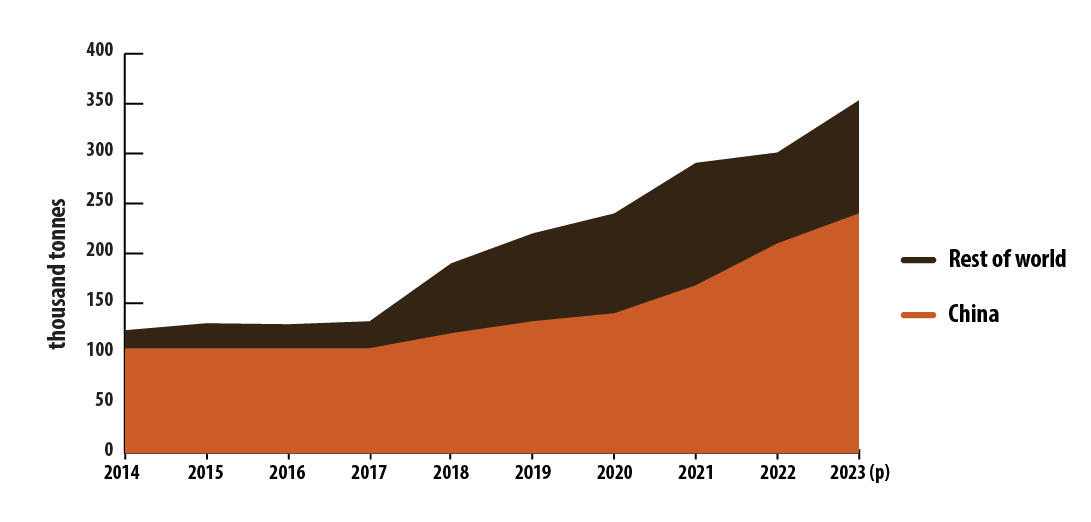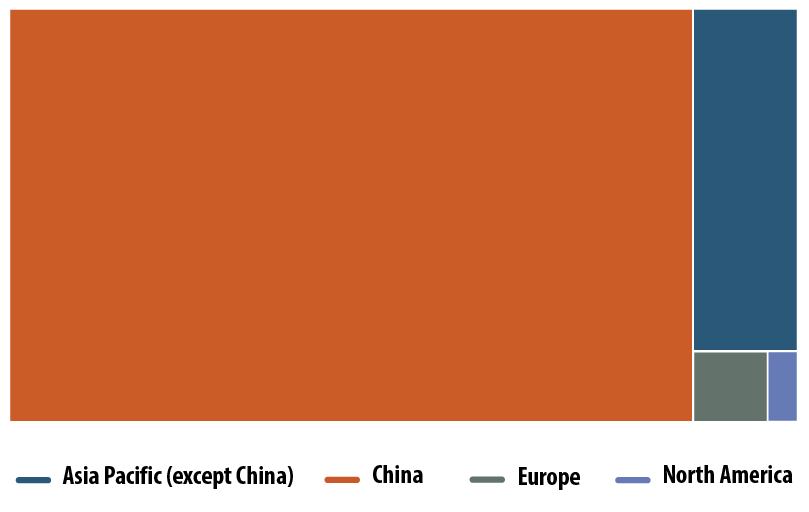
Rare earth elements (REEs) consist of 17 elements, including the 15 lanthanides from the periodic table, along with the transition metals scandium and yttrium. The latter two elements exhibit similar properties to the lanthanides and are typically found in the same ore deposits. REEs are key components in many electronic devices that we use in our daily lives, as well as in a variety of industrial applications.
Key facts
- Canada holds some of the largest known reserves and resources of rare earth metals globally, estimated at over 15.2 million tonnes of rare earth oxide in 2023.
- The manufacturing of permanent magnets is the largest global use for REEs, accounting for 45% of total demand in 2023.
- China is the world’s largest producer with an estimated 240,000 tonnes of mined REEs and 189,179 tonnes of refined REEs in 2023, accounting for 70% of global mined production and 87% of global refined production.
- Although many countries, including Canada, possess REE reserves and resources, producing these metals involves complex separation and refining processes.
Learn more about rare earth elements
 Uses
Uses
REEs are critical to a wide range of industrial and high-tech applications, including electronics, clean energy, aerospace, automotive, and defence. Their unique physical, chemical, magnetic, and luminescent properties enhance efficiency, durability, and performance while enabling the miniaturization of electronic components and alloys.
The largest and most important use of REEs is in the production of permanent magnets, which accounted for 45.2% of global demand in 2023. These magnets are essential for products like cell phones, televisions, computers, automobiles, MRI machines, jet aircraft, and more.
REEs are also vital in clean technology and alternative energy systems, such as wind turbines, fuel cells, rechargeable batteries, and electric vehicles.
Thanks to their luminescent properties, REEs are used in applications like LCD screens, LEDs, lasers, and fluorescent lighting. They also play a role in catalytic converters, optical glass for camera lenses, and polishing powders used in semiconductor manufacturing.
Rare earth element uses, 2023

Text version
This chart illustrates global demand for REEs by market sector in 2023. The largest share is attributed to magnets (45.7%), followed by catalysts (16.4%), polishing powders (10.9%), metallurgical uses (6.6%), glass (6.2%), ceramics (3.1%), batteries (2.0%), phosphors (0.5%), and pigments (0.3%). Other uses accounted for the remaining 8.4%. In terms of specific REEs, neodymium had the highest demand (33%), followed by cerium (32%), lanthanum (20%), praseodymium (7%), yttrium (3%), with the remaining REEs making up 5%.
 Production
Production
Although Canada is not yet a commercial producer of rare earth elements, it hosts several advanced exploration projects and holds some of the largest measured and indicated reserves and resources of REEs globally. Canada’s reserves and resources are estimated at 15.2 million tonnes of rare earth oxide.
Canadian REE projects

Text version
This map shows the location, status, and stage of the largest Canadian REE projects.
Northwest Territories
- Nechalacho T-Zone and Tardiff-Zone project – feasibility complete
- Nechalacho Basal-Zone project – feasibility complete
British Columbia
- Wicheeda project – active at the prefeasibility stage
Alberta
- SBH Black Shale project – active at the prefeasibility stage
Saskatchewan
- Alces Lake project – active at the target outline stage
- Falcon Point project – active at the reserve development stage
- Saskatchewan Research Council (SRC) Rare Earth Processing Facility project – active at the processing stage
- Vital Metals Saskatoon Rare Earth Processing Facility project – suspended/on hold at the processing stage
Ontario
- Clay-Howells project – active at the reserve development stage
- Prairie Lake project – active at the reserve development stage
- Lackner Lake project – suspended/on hold at the resource estimate stage
- Elliot Lake project – suspended/on hold at the resource estimate stage
- Lavergne-Springer project – active at the reserve development stage
Quebec
- Eldor (Ashram) project – active at the prefeasibility stage
- Strange Lake project – active at the advanced exploration stage
- Crater Lake project – active at the preliminary economic assessment stage
- Kwyjibo project – active at the prefeasibility stage
- Niobec - REE Zone project – inactive at the resource estimate stage
- Montviel project – active at the prefeasibility stage
- Sorel-Tracy Scandium Demonstration Plant – active at the processing stage
- Kipawa (Zeus) project – suspended/on hold at the feasibility stage
- St-Bruno Rare Earth Recycling Demonstration Plant project – active at the processing stage
- St. Honoré property – active at the reserve development stage
Newfoundland and Labrador
- Red Wine project – active at the reserve development stage
- Port Hope Simpson (Foxtrot) project – active at the prefeasibility stage
REEs are classified as either “light” or “heavy”:
- Light REEs include lanthanum, cerium, praseodymium, neodymium, promethium, samarium, europium, gadolinium, and scandium. These elements are naturally more abundant, and generally, there is a surplus supply globally. However, praseodymium and neodymium, which are essential in wind turbines and electric vehicles, are exceptions and are in high demand.
- Heavy REEs include terbium, dysprosium, holmium, erbium, thulium, ytterbium, lutetium, and yttrium. These are primarily produced in China and are in more limited supply compared to light REEs. Global efforts are ongoing to bring new resources to the market.
Many of Canada’s most advanced REE exploration projects contain high concentrations of the highly valued heavy REEs, which are crucial for high-tech and clean-energy applications.
Learn more about why rare earth elements are important.
 International context
International context
China is the world’s leading producer of REEs, accounting for 68% of global mine production in 2023, estimated at 240,000 tonnes. The United States, Australia, Burma (Myanmar), and Thailand collectively produced most of the remaining REEs. Notably, China remains almost the sole producer of the highly valued heavy REEs.
| Ranking | Country | Tonnes | Percentage of total |
|---|---|---|---|
| 1 | China | 240,000 | 68% |
| 2 | United States | 43,000 | 12% |
| 3 | Australia | 18,000 | 5% |
| 4 | Burma (Myanmar) | 38,000 | 11% |
| 5 | Thailand | 7,100 | 2% |
| - | Other countries | 7,220 | 2% |
| - | Total | 353,320 | 100% |
The United States was the world’s top REE supplier until China’s rise in the mid-1990s. China maintained its near-monopoly on REE supply until 2012, when the now-bankrupt American company Molycorp Inc. and Australia’s Lynas Rare Earths Ltd. began commercial production.
World REE mine production, 2014–2023 (p)

Text version
This graph illustrates the mine production of rare earth elements in China compared to the rest of the world from 2014 to 2023. In 2014, China’s estimated mine production was 105,000 tonnes, while the rest of the world produced 18,000 tonnes. From 2014 to 2017, China’s annual mine production remained stable at 105,000 tonnes, while production from the rest of the world rose to 26,800 tonnes.
Starting in 2018, mine production surged in both China and the rest of the world. China’s production climbed to 120,000 tonnes in 2018 and reached 240,000 tonnes by 2023. Likewise, production from the rest of the world increased to 70,000 tonnes in 2018, peaked at 123,000 tonnes in 2021, then decreased to 91,000 tonnes in 2022, before rebounding to 113,000 tonnes in 2023.
The process of separating rare earth oxides from the mined REE ore involves multiple steps, including crushing, grinding, chemical leaching, and solvent extraction. The production of refined REEs is highly concentrated in China, which accounts for 87% of the world’s supply.
World supply of REEs (refined), 2023

Text version
This graph illustrates the global supply of refined rare earth elements by region in 2023. China dominates the market, supplying 86.8% of the refined REEs, followed by the Asia Pacific region (excluding China) at 11.0%. Europe accounts for 1.6% of the supply, while North America contributes a mere 0.7%.
Notes and sources
(p) preliminary
Totals may be different because of rounding.
Uses
- Rare earth element uses, 2023
- Wood Mackenzie
Production
- Reserves and resources
- Natural Resources Canada, compiled from company reports
- Includes reserves and minerals resources (measured or indicated). Although Canada’s REE resources continue to exist, projects may be on hold, and the corporate entities developing these resources may no longer be solvent or may have changed focus to other mineral deposits or business segments.
- Canadian REE projects
- Company websites, press releases and NI-43-101 reports
International context
- World mine production of REEs, by country, 2023 (p)
- U.S. Geological Survey
- World REE mine production, 2014–2023 (p)
- Global Rare Earths Short Term Outlook by Wood MacKenzie
- World supply of REE (refined), 2023
- Wood Mackenzie